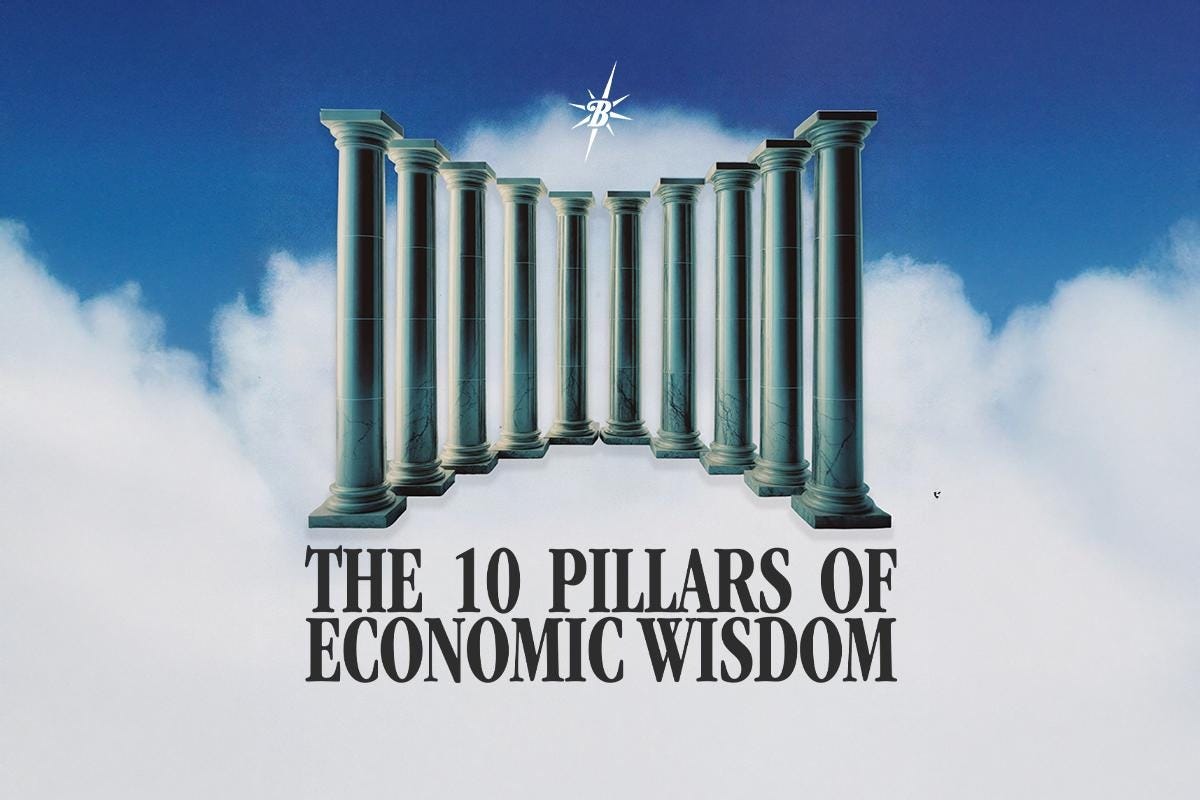The Ten Pillars of Economic Wisdom
The goal of The Believe! Journal is to restate America’s founding principles, and in this issue, centered on Free Enterprise, we could think of no better introduction to our theme than The Ten Pillars of Economic Wisdom. Conceived as etchings in bronze by the American Economic Foundation and displayed at the 1964 World’s Fair, they were purchased by Amway founders Jay Van Andel and Rich DeVos in 1973, and are now enshrined in sculpture at Amway’s World Headquarters in Ada, Michigan. They speak to our Free Enterprise system’s resiliency while also identifying threats to its integrity, such as excessive regulation and ill-conceived economic stimulus programs.
The Ten Pillars of Economic Wisdom
Nothing in our material world can come from nowhere or go nowhere, nor can it be free: everything in our economic life has a source, a destination and a cost that must be paid.
Government is never a source of goods. Everything produced is produced by the people, and everything that government gives to the people, it must first take from the people.
The only valuable money that government has to spend is that money taxed or borrowed out of the people’s earnings. When government decides to spend more than it has thus received, that extra unearned money is created out of thin air, through the banks, and when spent, takes on value only by reducing the value of all money, savings and insurance.
In our modern exchange economy, all payroll and employment come from customers, and the only worthwhile job security is customer security: if there are no customers, there can be no payroll and no jobs.
Customer security can be achieved by the worker only when he cooperates with management in doing the things that win and hold customers. Job security, therefore, is a partnership problem that can be solved only in a spirit of understanding and cooperation.
Because wages are the principal cost of everything, widespread wage increases, without corresponding increases in production, simply increase the cost of everybody’s living.
The greatest good for the greatest number means, in its material sense, the greatest goods for the greatest number which, in turn, means the greatest productivity per worker.
All productivity is based on three factors:
natural resources, whose form, place and condition are changed by the expenditure of
human energy (both muscular and mental), with the aid of
tools.
Tools are the only one of these three factors that man can increase without limit, and tools come into being in a free society only when there is a reward for the temporary self-denial that people must practice in order to channel part of their earnings away from purchases that produce immediate comfort and pleasure, and into new tools of production. Proper payment for the use of tools is essential to their creation.
The productivity of the tools—that is, the efficiency of the human energy applied in connection with their use—has always been highest in a competitive society in which the economic decisions are made by millions of progress-seeking individuals, rather than in a state, planned society in which those decisions are made by a handful of all-powerful people, regardless of how well-meaning, unselfish, sincere and intelligent those people may be.
Our upcoming content explores how intricately these Pillars are woven into the fabric of American life, the rights and obligations they confer on our citizens, and the importance of upholding them during these challenging times.
Artist Bernie DeSoyer’s sculptural setting for the Ten Pillars of Economic Wisdom, originally Displayed at the 1964 World’s Fair.







I had the honor of reading these personally and hearing DeVos and VanAndel speak about
their significance !! They are more true today and need to be taught ,,, than over 40 yrs ago.
Rick
Beautiful